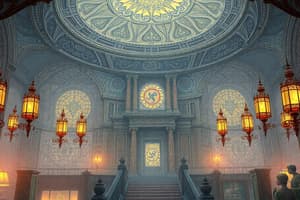Podcast
Questions and Answers
Define totalitarianism.
Define totalitarianism.
Totalitarianism is when the government controls everything.
What is fascism?
What is fascism?
Fascism is a political ideology where one leader has total power.
Explain the concept of communism.
Explain the concept of communism.
Communism is when all property is owned by the community.
What was the main focus of surrealism as an art movement?
What was the main focus of surrealism as an art movement?
Who was Emperor Hirohito?
Who was Emperor Hirohito?
The May Fourth Movement was a 1919 protest against foreign influence in China.
The May Fourth Movement was a 1919 protest against foreign influence in China.
Flashcards are hidden until you start studying
Study Notes
Totalitarianism and Between the Wars
- Essential Question: Why did totalitarian governments emerge between World War I and World War II?
Key Terms and Concepts
- Totalitarianism: A government that controls everything
- Fascism: werA system of government where one leader has total po
- Communism: A system where all property is owned by the community
- Socialism: A system where the government owns and controls some parts of the economy
- Nazi: A party led by Hitler
- Great Depression: A global economic downturn in the 1930s
- Twenty-One Demands: Japan's demands for more control and influence in China during World War I
- May Fourth Movement: A 1919 protest in China against foreign influence
- Guomindang: The Nationalist party in China
- The Long March: A 6,000-mile march by Mao Zedong and his followers in 1934-5, during which many civilians were killed by Japanese soldiers
- Karl Marx: The founder of the Communist party
- Mao Zedong: The leader of the Communist party in China
- Lenin: The founder of the Bolshevik party
- Emperor Hirohito: The Emperor of Japan during World War II
- Manchuria: A region in China invaded by Japan in 1931
- Ultranationalists: Extremists who believe in aggressive foreign policy
- Flapper: A young woman in the 1920s known for her freedom and independence
- Prohibition: The ban on alcohol in the US from 1920-1933
- Surrealism: An art movement that focuses on dream-like images
- Sigmund Freud: The founder of psychoanalysis
- Harlem Renaissance: A revival of African American culture in the 1920s
- Abstract Art: An art movement that does not show reality directly
- Maginot Line: A French defense line built before World War II
- Disarmament: The reduction of military forces and weapons
- Kellogg-Briand Pact: An agreement in 1928 to avoid war
- Overproduction: The production of more goods than people can buy
- FDR's New Deal: A series of reforms set by President Roosevelt
- Benito Mussolini: The Italian dictator and founder of fascism
- Black Shirt: Mussolini's fascist followers
- Joseph Stalin: The Russian ruler who used propaganda to manipulate people and was feared for his strict rules
- Gulag: A Soviet prison camp
- Socialist Realism: An art movement that shows Soviet life in a positive light
- Atheism: The belief of not having a religion
- Weimar Republic: A government in Germany after World War I
- Adolph Hitler: The leader of the Nazi party
- Gestapo: The Nazi secret police
- Nuremberg Laws: Laws that discriminated against Jews and took away their rights
- Pacifism: The belief of avoiding war
- Indoctrination: Teaching people to believe something without questioning
- Censorship: The control of information
- The Great Purge: Stalin's campaign to eliminate opposition, which involved fake trials and executions
Review Questions
- Similarities between totalitarian regimes: Single leaders with power, ability to legally kill, and prioritization of state over individual rights
- Post-war disillusionment and the rise of totalitarian governments: Totalitarian governments took advantage of people's disappointment with the Treaty of Versailles and the lack of stability in Germany
- Treaty of Versailles and the rise of Hitler: The harsh conditions of the Treaty led to resentment and economic instability in Germany, which Hitler used to gain power
- Nuremberg Laws: Hitler passed the laws to initiate discrimination against Jews and take away their rights
- Goals of the Big Three Leaders: Wilson wanted to establish lasting peace, Lloyd George aimed to protect the British Empire, and Clemenceau sought to ensure security for France
Studying That Suits You
Use AI to generate personalized quizzes and flashcards to suit your learning preferences.




